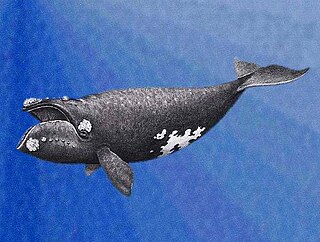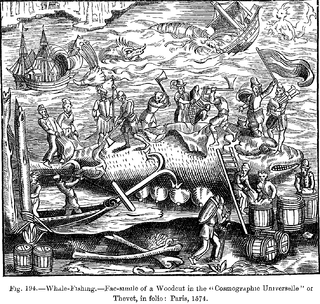Related Research Articles

The gray whale, also known as the grey whale, is a baleen whale that migrates between feeding and breeding grounds yearly. It reaches a length of 14.9 meters (49 ft), a weight of up to 41 tonnes (90,000 lb) and lives between 55 and 70 years, although one female was estimated to be 75–80 years of age. The common name of the whale comes from the gray patches and white mottling on its dark skin. Gray whales were once called devil fish because of their fighting behavior when hunted. The gray whale is the sole living species in the genus Eschrichtius. It is the sole living genus in the family Eschrichtiidae, however some recent studies classify it as a member of the family Balaenopteridae. This mammal is descended from filter-feeding whales that appeared during the Neogene.

Whaling is the hunting of whales for their usable products such as meat and blubber, which can be turned into a type of oil that was important in the Industrial Revolution. Whaling was practiced as an organized industry as early as 875 AD. By the 16th century, it had become the principal industry in the Basque coastal regions of Spain and France. The whaling industry spread throughout the world and became very profitable in terms of trade and resources. Some regions of the world's oceans, along the animals' migration routes, had a particularly dense whale population and became targets for large concentrations of whaling ships, and the industry continued to grow well into the 20th century. The depletion of some whale species to near extinction led to the banning of whaling in many countries by 1969 and to an international cessation of whaling as an industry in the late 1980s.
The International Whaling Commission (IWC) is a specialised regional fishery management organisation, established under the terms of the 1946 International Convention for the Regulation of Whaling (ICRW) to "provide for the proper conservation of whale stocks and thus make possible the orderly development of the whaling industry".

Right whales are three species of large baleen whales of the genus Eubalaena: the North Atlantic right whale, the North Pacific right whale and the Southern right whale. They are classified in the family Balaenidae with the bowhead whale. Right whales have rotund bodies with arching rostrums, V-shaped blowholes and dark gray or black skin. The most distinguishing feature of a right whale is the rough patches of skin on its head, which appear white due to parasitism by whale lice. Right whales are typically 13–17 m (43–56 ft) long and weigh up to 100 short tons or more.

The North Pacific right whale is a very large, thickset baleen whale species that is extremely rare and endangered.

This article discusses the history of whaling from prehistoric times up to the commencement of the International Whaling Commission (IWC) moratorium on commercial whaling in 1986. Whaling has been an important subsistence and economic activity in multiple regions throughout human history. Commercial whaling dramatically reduced in importance during the 19th century due to the development of alternatives to whale oil for lighting, and the collapse in whale populations. Nevertheless, some nations continue to hunt whales even today.
Leviathan is a Biblical sea monster.
John Earl Haynes is an American historian who worked as a specialist in 20th-century political history in the Manuscript Division of the Library of Congress. He is known for his books on the subject of the American Communist and anti-Communist movements, and on Soviet espionage in America.
David M. Glantz is an American military historian known for his books on the Red Army during World War II and as the chief editor of The Journal of Slavic Military Studies.

Paul Winter is an American saxophonist, composer, and bandleader. He is a pioneer of world music and earth music, which interweaves the voices of the wild with instrumental voices from classical, jazz and world music. The music is often improvised and recorded in nature to reflect the qualities brought into play by the environment.

Commercial whaling in the United States dates to the 17th century in New England. The industry peaked in 1846–1852, and New Bedford, Massachusetts, sent out its last whaler, the John R. Mantra, in 1927. The Whaling industry was engaged with the production of three different raw materials: whale oil, spermaceti oil, and whalebone. Whale oil was the result of "trying-out" whale blubber by heating in water. It was a primary lubricant for machinery, whose expansion through the Industrial Revolution depended upon before the development of petroleum-based lubricants in the second half of the 19th century. Once the prized blubber and spermaceti had been extracted from the whale, the remaining majority of the carcass was discarded.

Sperm whaling is the human practice of hunting sperm whales, the largest toothed whale and the deepest-diving marine mammal species, for the oil, meat and bone that can be extracted from the cetaceans' bodies.

C. Scott Baker is an American molecular biologist and cetacean specialist. He is Associate Director of the Marine Mammal Institute at Oregon State University. He is also Adjunct Professor of Molecular Ecology and Evolution at the University of Auckland, and Editor of the Journal of Heredity.

Anti-whaling refers to actions taken by those who seek to end whaling in various forms, whether locally or globally in the pursuit of marine conservation. Such activism is often a response to specific conflicts with pro-whaling countries and organizations that practice commercial whaling and/or research whaling, as well as with indigenous groups engaged in subsistence whaling. Some anti-whaling factions have received criticism and legal action for extreme methods including violent direct action. The term anti-whaling may also be used to describe beliefs and activities related to these actions.

Bernd Gerhard Würsig is an educator and researcher who works mainly on aspects of behavior and behavioral ecology of whales and dolphins. Much of his early work was done in close collaboration with his wife Melany Ann Würsig, and they have published numerous manuscripts and books together. He is now Professor Emeritus at Texas A&M University, teaching only occasionally but still involved with graduate student and other research. He is especially active with problems and potential solutions concerning Indo-Pacific humpback dolphins, Sousa chinensis, in and surrounding waters of Hong Kong.
Erich Hoyt is a whale and dolphin (cetacean) researcher, conservationist, lecturer and author of 26 books and more than 700 reports, articles and papers. His book Marine Protected Areas for Whales, Dolphins and Porpoises, has been widely reviewed as the "definitive reference of the current extent of cetacean ecosystems-based management" and as "a unique and essential book for anybody interested in the conservation and protection of cetaceans. [This] definitive source on MPAs marine protected areas for cetaceans…will influence the design and management of this important and rapidly developing conservation tool." Choice listed the book as an "Outstanding Academic Title’ for the year 2012. Since 2013, as Research Fellow with Whale and Dolphin Conservation (WDC) and IUCN SSC/WCPA Marine Mammal Protected Areas Task Force co-chair with Giuseppe Notarbartolo di Sciara, Hoyt has focussed on the creation and development of the new conservation tool of Important Marine Mammal Areas, or IMMAs. In 2016, following a MAVA Foundation pilot project to identify IMMAs in the Mediterranean, the Task Force's GOBI collaboration funded by the German Climate Initiative (IKI) began a six-year project to identify and implement IMMAs across most of the southern hemisphere. The IMMA tool has been received and widely endorsed by the Convention on Migratory Species (CMS), the Convention on Biological Diversity (CBD), various commissions within the International Union for Conservation of Nature (IUCN), the International Whaling Commission, as well as national governments and scientists.

Commercial whaling in Britain began late in the 16th century and continued after the 1801 formation of the United Kingdom and intermittently until the middle of the 20th century.
Rhys Morgan Richards is a former New Zealand diplomat and a current historian and ethnographer. He has written extensively on maritime history and Pacific artifacts and art. He has also spoken on these subjects on New Zealand radio and at many conferences and seminars around the world.

Russian whaling has been conducted by native peoples in the Chukotka region of Russia since at least 4,000 years ago by native Yupik and Chukchi people, but commercial whaling did not begin until the mid-19th century, when companies based in Finland sent out vessels to the Pacific. It was not until 1932 that modern pelagic whaling began to take off with the purchase of an American cargo ship which was renamed the Aleut, which was the only Soviet factory ship until World War II. After the war, with the need for a stronger Soviet economy and rapid industrialization of the country during the 1940s and 1950s, Soviet whaling took off and became a truly global industry. The first Soviet whalers reached the Antarctic during the 1946–47 season with the factory ship Slava and then underwent a rapid expansion during the late 1950s in which 5 new fleets were added within a 4-year span: Sovetskaya Ukraina in 1959, Yuriy Dolgorukiy in 1960, and Sovetskaya Rossiya in 1961 for the Antarctic, and finally two large fleets in 1963 for the North Pacific. Thus, by the early 1960s Soviet whaling had truly become a global industry, operating in every ocean except the North Atlantic and undertaking voyages that could last as long as seven months each. From 1964 to 1973, the Soviet Union was considered by some the biggest whaling nation in the world.
The fish case or caviar case in the USSR was a series of corruption, misappropriation, and smuggling cases related to fish trade uncovered in the late 1970s. The organized crime group in question is sometimes referred to as the (Soviet) fish mafia.
References
- ↑ "Author Ryan Tucker Jones Takes On the 'Red Leviathan: The Secret History of Soviet Whaling' - The Moscow Times".
- ↑ Andrews, Helen (December 30, 2023). "Red Menace, White Whale". The American Conservative.
- ↑ "Ryan Tucker Jones, "Red Leviathan: The Secret History of Soviet Whaling" (U Chicago Press, 2022)". New Books Network.